Yesterday we examined how Instagram has evolved as a shopping tool. It has been able to condition users to not only treat it as a place to see what their friends (and influencers) are up to, but also as a place to discover trending food and fashion. This is a key move to boost its core ad monetization model.
One thing that makes it all work is that the UX is aligned with user intent. They don’t perceive sponsored posts as being out of context as they’re in shopping mode. The same intent signaling is at the heart of Google’s success as an ad-supported business. And this dynamic runs deep in another player: Amazon.
This is why Amazon’s advertising business continues to grow. For a few years, it’s been pegged the most legitimate threat to the ad-world duopoly – Google and Meta. Indeed, Amazon’s ad revenue growth comes as these giants (especially Meta) see attrition from a perfect storm of revenue-depleting factors.
The latest milestone in this saga is the revelation that Amazon’s advertising business has exceeded the revenue stream we hear about more often: Amazon Prime. This puts Amazon’s ad-world prominence and promise into perspective. It’s a sleeping giant due to its fitting ingredients for an ad revenue superpower.
Prominence and Promise
Going deeper into the numbers, Amazon made almost $36 billion in ad revenue in the 12 months trailing its Q3 earnings. That compares to just over $34 billion in subscription revenue. The latter includes Prime but also video, music, eBooks, and Audible subscriptions (some of which can be bundled with Prime).
So what are these ads? 90 percent of ad revenue is from search ads. These are sponsored results in search that takes place on Amazon. Though ample inbound traffic comes from Google searches that deep-link to Amazon product listings, shoppers increasingly go straight to Amazon, then search.
Correspondingly, Amazon sellers can amplify their exposure by buying into various sponsored placement options. These follow a Google-like bid marketplace model. And as we’ve reported, 73 percent of Amazon sellers buy these ads. Moreover, 89 percent of U.S. users are satisfied with the UX and ad load.
And it doesn’t end there. Search has the most scale, but other Amazon properties could begin to comprise a broader network of multi-media and cross-channel offerings. We’re talking streaming video via Prime (now reaching 120 million monthly users), as well as channels like Alexa and Twitch.
First-Party Advantage
The other big advantage for Amazon’s ad business is its first-party orientation. As background, most privacy restrictions don’t inhibit collecting user data for content/ad targeting on one’s own properties. The penalty flag is thrown when companies share or sell such data to third parties.
So in a world that favors first-party networks — defined as web properties under the same ownership — it doesn’t get much bigger than Amazon. So it could attract advertisers looking for the reach of an ad network, but the unfettered targeting and contextual relevance of the world’s biggest online store.
Meanwhile, from a strategic perspective, Amazon has so much scale and reach through its eCommerce business that integrating an ad business is logical and adjacent. Moreover, it’s a key diversification move as giants like Amazon need to continue finding new revenue streams as their core businesses mature.
If this sounds familiar, it’s the factor that drove AWS into existence, which has been one of the most successful tech stories of the past decade. That’s all to say that Amazon is highly motivated to chase such adjacent revenue streams, which means we’ll continue to see it chipping away at the duopoly.



